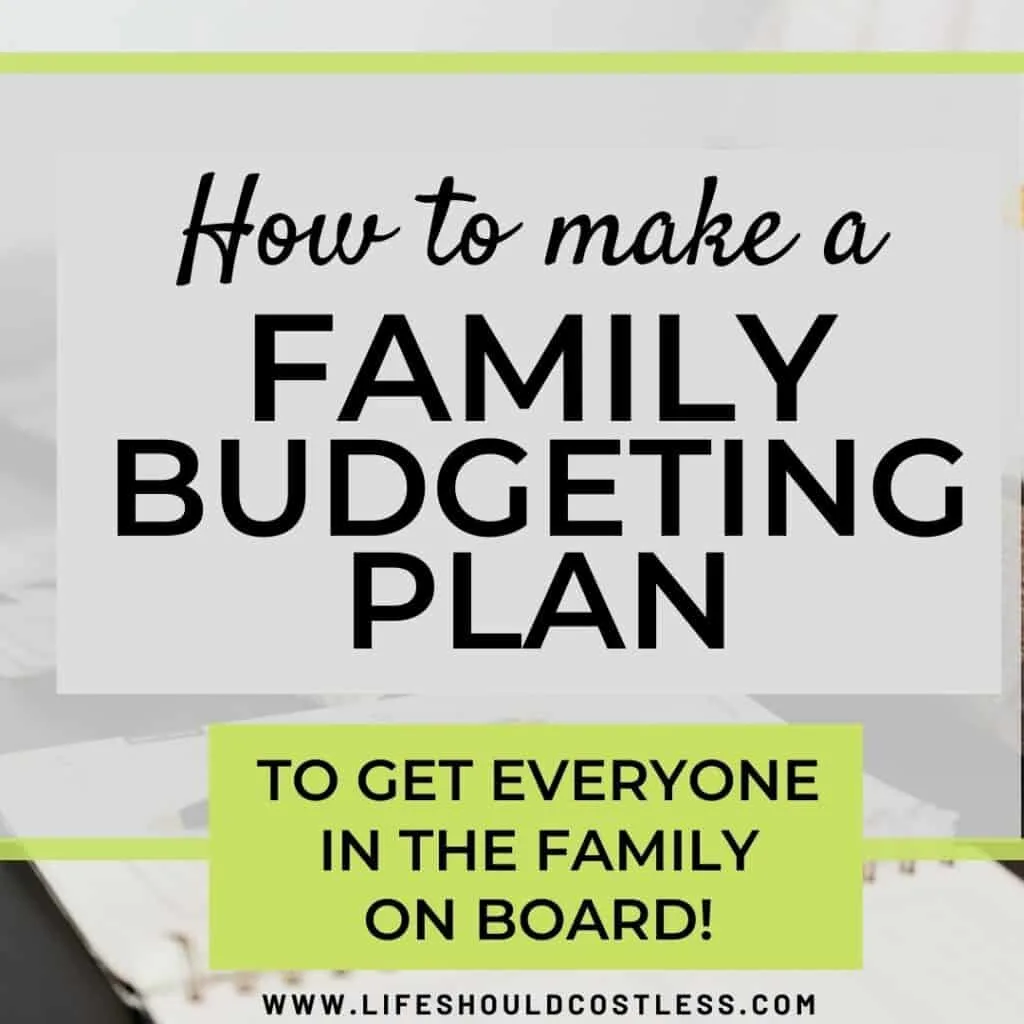Budgeting is one of the best ways to help you stay on top of your family’s finances from month to month. However, staying on budget can be difficult if everyone in the family isn’t on board with the program. To help get your family involved in the budgeting process, why not put together a family budgeting plan with a little bit of input from everyone? These seven simple steps will help you create a simple budgeting plan that will get you all on the same page in almost no time at all.

Figure Out Your Income
The first step to creating your family budget is to figure out how much money you have coming in, and how much you have going out of your household each month.
If you work a 9-to-5 job, your income is probably pretty regular. That means you already know how much you make each month.
Though if you, or a maybe a spouse, have irregular income, it’s a good idea to calculate your average monthly income before tackling your family’s expenses.
To find your average monthly income, look at your income for the last 12 months. Add each month together, then divide that total number by 12. This will tell you what you make on average per month and will help you know where to start.
Know How Much You’re Spending
Once you have your income figured out, you can start diving into your expenses. Household expenses vary from family to family. But most have a similar set of expense categories most of their spending falls into. When creating your budget, consider adding these expense categories to your family budgeting plan:
- Housing: Whether you pay monthly rent or have a mortgage, most families will have housing expenses that need to be included in their monthly plan.
- Utilities: Common monthly expenses related to your home are considered utilities. This category often includes electricity, water, heating, internet, phone, and cable bills.
- Transportation: All the expenses you incur each month that help you move from place to place can be included in the transportation category. That includes car expenses, like gas, rideshare costs, maybe the cost to transport children to and from another parent from a previous marriage, or public transportation fees.
- Insurance: Each of your monthly insurance expenses will fall into the insurance category, including medical, dental, vision, life, home owners, and auto insurance. You can also include medical expenses, like co-pays for doctor’s visits, in this budgeting category.
- Groceries and household expenses: Purchasing food and household supplies each month will go into this variable budgeting category when making a budgeting plan for your family.
- Miscellaneous expenses: All other expenses will fall into this category. Most of these expenses include fun spending, like shopping or entertainment. It should also include unexpected expenses, like home or vehicle repairs.
After breaking down your spending into each of these categories, you can get a better idea of how much your family is spending every month. Then, you can start pinpointing areas where you can cut back to reduce your spending.
Reduce Your Debt
Once you have your expenses outlined, it’s time to start evaluating where you can cut back. Reducing your spending will help improve your family’s financial situation. One of the biggest ways to help reduce your family’s expenses is to eliminate your family’s debt. Before you begin saving for fun things, like a family vacation, you should consider paying down your debt.
This budgeting exercise probably won’t excite many of your family members. Though it is an important step toward gaining financial freedom for your family. That means putting any extra money you have in your budget toward paying down your family’s debt before moving on to the next step of your budgeting plan.
Establish an Emergency Fund
Once your family has gotten rid of your debt, it’s time to start thinking about the future. Creating an emergency fund is one of the best ways to prepare your family for a rainy day. Whether you need to make an unexpected repair to your home or lose your job, this fund will help. Having money set aside for emergencies is an essential part of creating a family budgeting plan.
Ideally, your family emergency fund should have at least three months of expenses in it to help cover financial costs if you are out of work. But there’s no reason to stop saving after you’ve accumulated three months of expenses. Reaching 12 months of expenses in your emergency fund will ensure your family is ready for any possible type of unexpected expense that comes your way.
I know that even the goal of “three months worth of expenses” may sound impossible to set aside, but maybe if you break it down into $500 or $1000 increments it will be a much easier task.
Set Financial Goals for Your Family
Once you have the boring parts of your family budgeting plan complete, your family can have some fun coming up with new financial goals to achieve. This is a great opportunity to get your family involved in the family budgeting plan. Hold a family meeting and let your family members have input into the financial goals you hope to achieve. These family budgeting goals are great ideas to consider:
- Family vacation: Make a fun savings goal for your family by saving up to go on a big family vacation together.
- Retirement savings: Set yourself up for the future by contributing money to a retirement fund.
- New house: Help your family improve your living arrangements by setting money aside to purchase a new house.
- New car: Or maybe your car needs an upgrade. Create a savings goal to help your family afford to buy a new car for you or your teenager.
- Swimming pool: I guarantee your kids will help try to fund something as cool as having a family pool. When I was a kid my friends family saved up and they had a massive jar that everyone added money to… it took them a few years of saving but they got their pool and we all had a blast there.
Make a Family Budgeting Plan
Now that you have an idea of where your family wants to spend the money you save, it’s time to make a budgeting plan the entire family can help with. After picking a goal to strive for, ask your family to come up with ways they can help achieve that goal. There are a variety of steps you and your family can take to help reach your financial goals.
- Make more money. One of the best ways to improve your family’s financial situation is to find a way to make more money. Ask for a raise or look for a side hustle that will help you add to your income this year. Also, if you have kids at home who are old enough to get a job, let them contribute to the family’s financial goals, too.
- Reduce your variable spending. Ask your family members to think about ways they can help reduce the family’s monthly spending. Whether you decide to eat out less or cut back on entertainment expenses, you can work together to reduce your spending. It’s a great way to get the family involved in your family budgeting plan.
- Negotiate your fixed monthly expenses. You can also help reduce your fixed expenses with a little bit of negotiation. Contact your service provider to find ways you can reduce your monthly payment. You can negotiate with providers like your cell phone company or insurance providers. Or look for ways to cut back on your fixed monthly spending by cutting the payment altogether, like your cable bill or gym membership. You could even cut back on movie streaming services.
Re-evaluate Frequently
Your family’s budget should never be set in stone. That means you’ll need to re-evaluate your budgeting plan at least every few months. This will help you see what’s working and what can be improved upon.
Take the time to examine your budgeting plan every once in a while. This will help you be sure you’re making progress toward your goals and not just spinning your wheels. The great thing about reevaluating is that if something doesn’t seem to be working, you can make some changes to your budget to keep moving forward in your family’s financial plan.
That’s really all the ideas I have to share today on budgeting, but if you would like to read up on all of my past financial tips, make sure to check out my MONEY SECTION.
Thanks so much for stopping by my blog and for the support. If you really liked this post, please make sure to share it via social media. Thanks again!~Sarah

How To Follow & Support This Site
- If you would like to subscribe to my email list, go here.
- Make sure to follow along via social media, by going here.
- If you would like to learn how to really show your support to this site (at no cost to you), go here.
- If you would like to make a direct donation to the site, go here.
Here are links to several of my other financially savvy posts for your to read at your leisure:
